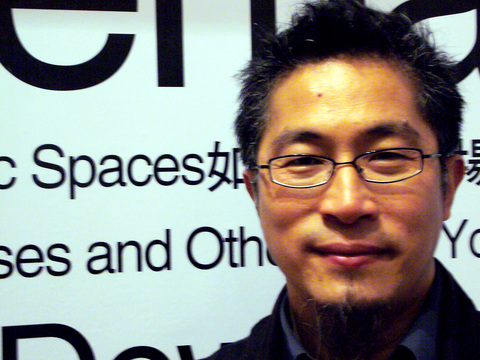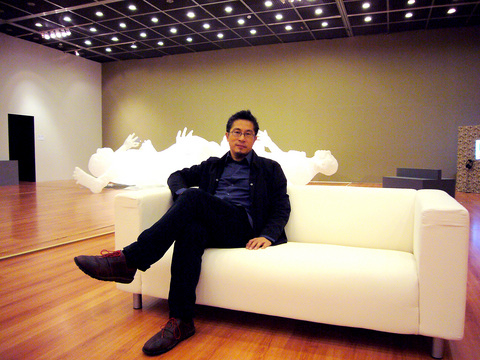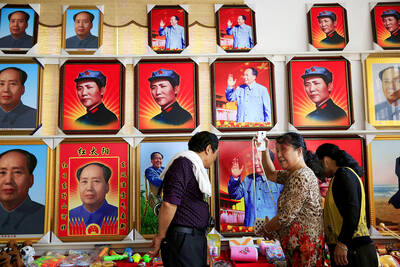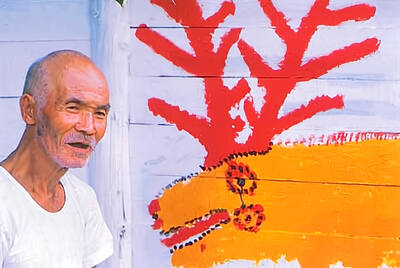The common perception of a curator is a highly educated, distinguished man in a three-piece suit, smoking a pipe and leafing through old archive photos of ancient masters. Though Manray Hsu (徐文瑞) has a PhD in philosophy from Columbia University and wears a button down shirt, the independent curator who is based in Taipei and Berlin rarely spends time looking through boxes in the archives of old museums.
Like many contemporary artists, Hsu is concerned with how art affects our daily lives and creates a dialogue within the global and local contexts. This notion shapes his entire outlook on the art he chooses for exhibits, such as Naked Life, currently running at the Museum of Contemporary Art, Taipei (MOCA).
Hsu differentiates between independent curators from institutional curators in two ways. First, he points out that independent curators don't work in or have an ongoing collaboration with any particular museum. Instead, they spend time moving from one museum or biennial to another picking and choosing projects that are most suited to their aesthetic vision. The corollary to this is that independent curators are also intellectually independent.

PHOTOS: NOAH BUCHAN, TAIPEI TIMES
"Freelance curators have [the] freedom … to develop ideas and projects in [their] own way. If you work in an institution you are more limited as to what you can do and what you can not do," he said.
Hsu also says that working independently enables the curator to collaborate closely with artists, which normally wouldn't be the case working inside an institution. "For me, independent means that I'm also more in contact with artists and those people in the field."
Collaborating with artists and working in the "field" has only become common in the past few decades. Until the 1970s, curators were predominately trained in art history, which had a tremendous influence on what hung on the walls of museums. "You still have an exhibition, but you don't rely on art history anymore. You can still do it, but art history is not the only framework. So you need to have people who can provide a smaller framework but still much bigger than the individual artwork. That's the curator's job. Framework providers," he said.

For Hsu, creating the proper framework for an exhibit necessarily involves a lot of travel because he seeks input from international artists.
"My job relies on my traveling. But an important part of this issue is contemporary culture, [which is] a global culture. There is no simple big narrative that can allow you to say, okay, I know the whole art world. So you need to have people from different parts of the world who can bring their perspective and their experience into the field. And normally these people are curators and theorists," he said.
Hsu's global perspective is readily apparent with the current lineup of artists exhibiting at MOCA who hail from as far a field as Iraq and as close to home as Japan. "[By] traveling, I've built my own conceptual network and this is another thing I bring into the art world," Hsu said.
According to Hsu, his extensive travels combined with a global outlook and a desire to directly cultivate talent fosters greater trust between the curator and artists because the latter are working directly with an individual, rather than an institution. The curator can then have a clearer picture of what the artist is trying to achieve because both sides are working together.
How art is classified according to culture is an important issue to Hsu who believes stereotypes of what a particular culture will produce need to be broken down.
One common notion that Hsu wants to rid the art world of is the idea that an artist's work is inseparable from their nationality.
"Just because this artist is from Iraq, then everything he does has to do with Iraq — this, for me, doesn't really make sense," he said. "When a Western artist exhibits in a professional exhibition, normally the exhibition will not mention the locality [where the ideas are formed] and I feel this is more questionable."
"Some artists are really conscious of their local history and some artists work on more formalistic issues inside art history so the idea of locality [is] relevant to artists in different ways, no matter if it is Western [or] Eastern."
The relevance of national history, borders and educational background is, Hsu believes, becoming less important. The question facing institutions is: can they react quickly enough?
Part of reacting to and participating in the social environment — whether global or local — involves formulating theories that help people understand the processes of change. For the biennial held earlier this year in Liverpool, Hsu developed an idea that shows how art can rejuvenate public spaces. Known as "archipuncture" it reveals how artwork in the public realm is connected to the energy flow of the city through its placement at particular points.
"Archipuncture for me ... provide[s] a perspective of how art can be related to the urban condition. Instead of just something that you look at … art also brings new energy flows to the place where it is exhibited. And this kind of new energy can be related to the health of the city," he said. Hsu makes it clear that this idea can be applied to any city throughout the world.
The exhibit at MOCA, in a similar manner to the 2006 Liverpool Biennial, involves both a global and local perspective. The title of the exhibit is meant to explore the contemporary mode of existence where anti-terrorism, border control and the gradual erosion of due process has stripped many citizens of their political rights and legal protections. The concepts embodied in Naked Life should have particular resonance for Taiwanese because of the country's forty-year history of martial law.
Naked Life is an attempt to raise awareness of global issues in a local context that moves beyond the cynicism of the polarizing politics that Hsu claims pervades Taiwan .

Taiwan can often feel woefully behind on global trends, from fashion to food, and influences can sometimes feel like the last on the metaphorical bandwagon. In the West, suddenly every burger is being smashed and honey has become “hot” and we’re all drinking orange wine. But it took a good while for a smash burger in Taipei to come across my radar. For the uninitiated, a smash burger is, well, a normal burger patty but smashed flat. Originally, I didn’t understand. Surely the best part of a burger is the thick patty with all the juiciness of the beef, the

The ultimate goal of the Chinese Communist Party (CCP) is the total and overwhelming domination of everything within the sphere of what it considers China and deems as theirs. All decision-making by the CCP must be understood through that lens. Any decision made is to entrench — or ideally expand that power. They are fiercely hostile to anything that weakens or compromises their control of “China.” By design, they will stop at nothing to ensure that there is no distinction between the CCP and the Chinese nation, people, culture, civilization, religion, economy, property, military or government — they are all subsidiary

Nov.10 to Nov.16 As he moved a large stone that had fallen from a truck near his field, 65-year-old Lin Yuan (林淵) felt a sudden urge. He fetched his tools and began to carve. The recently retired farmer had been feeling restless after a lifetime of hard labor in Yuchi Township (魚池), Nantou County. His first piece, Stone Fairy Maiden (石仙姑), completed in 1977, was reportedly a representation of his late wife. This version of how Lin began his late-life art career is recorded in Nantou County historian Teng Hsiang-yang’s (鄧相揚) 2009 biography of him. His expressive work eventually caught the attention

This year’s Miss Universe in Thailand has been marred by ugly drama, with allegations of an insult to a beauty queen’s intellect, a walkout by pageant contestants and a tearful tantrum by the host. More than 120 women from across the world have gathered in Thailand, vying to be crowned Miss Universe in a contest considered one of the “big four” of global beauty pageants. But the runup has been dominated by the off-stage antics of the coiffed contestants and their Thai hosts, escalating into a feminist firestorm drawing the attention of Mexico’s president. On Tuesday, Mexican delegate Fatima Bosch staged a